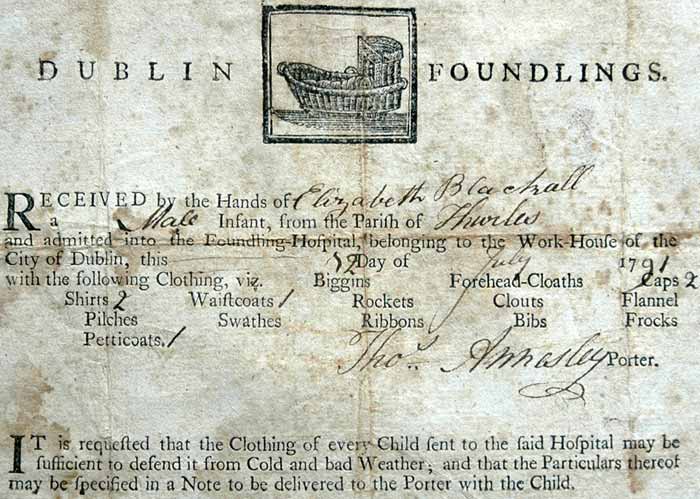An in-depth genealogical survey, funded by the Department of Children, will be conducted on a patch of land at the mother and baby home at Sean Ross Abbey, Roscrea, Co. Tipperary, where some locals people believe that children and babies may have been buried.
Some 1,090 children and babies, many of whom were under the age of three, are understood to have died over a period of almost four decades at this mother and baby home in Tipperary, run by the Sisters of the Sacred Hearts of Jesus and Mary.

Note from this receipt (billet), shown above, certain of the clothing names are no longer in use today.
Biggins – A bonnet tied behind the neck and made of wool or linen.
Clouts – Cloth diapers or nappies.
Flannel – A square of fabric wrapped around a child over the diaper or a long undergarment.
Forehead Clothes – Strip of cloth tied across the forehead to behind the ears for added warmth.
Pilches – Layers of cloth tied around the diaper in an effort to prevent leakage.
Swathes – Strips of cloth, usually of wool, wrapped around an infant’s body for warmth and to put pressure on the navel. Parents will be aware of the term “Swaddling”, – St Luke 2:7 “And she brought forth her firstborn son, and wrapped him in swaddling clothes, and laid him in a manger; because there was no room for them in the inn”.
Pic: G. Willoughby
The area of earth to be surveyed is understood to be located beside a designated burial ground known as “The Angel Plot”, but the area currently remains uncared for and is overgrown with heavy vegetation.
Sean Ross Abbey was one of the largest mother and baby homes within the Irish State, and contained a three-storey mansion, an orchard and a church on its grounds.
Some 6,079 babies were born there, to thousands of unmarried pregnant women who passed through its portals from 1931 until 1969. Babies born to unmarried girls in the home, were put up for adoption, with a known 487 of them sent to the United States of America.
Among its better known residents was Ms Philomena Lee, whose story featured in the book The Lost Child of Philomena Lee, (by author Martin Sixsmith) and the 2013 film, starring Judi Dench and Steve Coogan, [latter nominated for four Academy Awards, including ‘Best Actress’ for Judi Dench’s portrayal of Philomena Lee and Best Picture].
Four years ago, in 2019, as part of work then undertaken, about one tenth of “The Angel Plot” was excavated. Same examination revealed the remains of 42 infants on the site explored.
Note: In relation to the picture relating to Thurles, shown above; back in the year 1752, of the 691 children taken in charge by the Dublin Foundling’s Hospital, 365 children were dead by the end of that particular year. In 1757, burial of these children was described as “being chucked, naked into a hole, some eight or ten infants at a time”.
A report ordered by the Irish House of Commons regarding child mortality over the previous twelve years, ending in June 1796; same would reveal that of the 25,000 admitted more than 17,000 had died. Worse facts would be revealed in the five-year period between 1791 to 1796. Here, of the 5,016 infants sent to the Dublin Foundling’s Hospital infirmary, only one solitary child had survived.

Leave a Reply